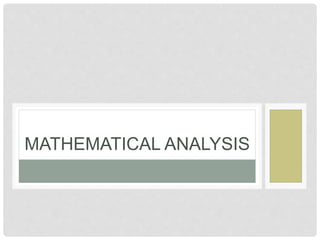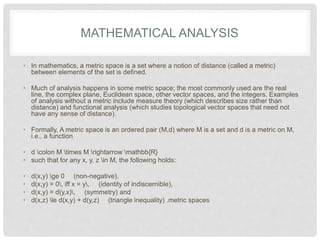Mathematical analysis is a branch of mathematics that studies concepts like differentiation, integration, limits, and infinite series. It evolved from calculus and can be applied to spaces with defined distances or nearness. Key areas include real analysis of real functions and sequences, complex analysis of functions of complex variables, and functional analysis which studies topological vector spaces. Measure theory assigns a size or number to subsets of a set, generalizing concepts like length, area and volume. Numerical analysis uses numerical approximations rather than symbolic manipulations to solve problems in mathematical analysis.

![WHAT IS MATEMATICAL ANALYSIS?
• Mathematical analysis is a branch of mathematics that
includes the theories of differentiation, integration,
measure, limits, infinite series, and analytic functions.[1]
These theories are usually studied in the context of real
and complex numbers and functions. Analysis evolved
from calculus, which involves the elementary concepts
and techniques of analysis. Analysis may be
distinguished from geometry; however, it can be applied
to any space of mathematical objects that has a
definition of nearness (a topological space) or specific
distances between objects (a metric space).](https://image.slidesharecdn.com/mathematicalanalysis-140815013256-phpapp02/85/Mathematical-analysis-2-320.jpg)
![HISTORY OF MATHEMATICAL ANALYSIS
• Mathematical analysis formally developed in the 17th century during the
Scientific Revolution,[2] but many of its ideas can be traced back to earlier
mathematicians. Early results in analysis were implicitly present in the early
days of ancient Greek mathematics. For instance, an infinite geometric sum is
implicit in Zeno's paradox of the dichotomy.[3] Later, Greek mathematicians
such as Eudoxus and Archimedes made more explicit, but informal, use of the
concepts of limits and convergence when they used the method of exhaustion to
compute the area and volume of regions and solids.[4] The explicit use of
infinitesimals appears in Archimedes' The Method of Mechanical Theorems, a
work rediscovered in the 20th century.[5] In Asia, the Chinese mathematician Liu
Hui used the method of exhaustion in the 3rd century AD to find the area of a
circle.[6] Zu Chongzhi established a method that would later be called
Cavalieri's principle to find the volume of a sphere in the 5th century.[7] The
Indian mathematician Bhāskara II gave examples of the derivative and used
what is now known as Rolle's theorem in the 12th century.[8]](https://image.slidesharecdn.com/mathematicalanalysis-140815013256-phpapp02/85/Mathematical-analysis-3-320.jpg)


![REAL ANALYSIS
• Real analysis (traditionally, the theory of functions of a
real variable) is a branch of mathematical analysis
dealing with the real numbers and real-valued functions
of a real variable.[12][13] In particular, it deals with the
analytic properties of real functions and sequences,
including convergence and limits of sequences of real
numbers, the calculus of the real numbers, and
continuity, smoothness and related properties of real-
valued functions.](https://image.slidesharecdn.com/mathematicalanalysis-140815013256-phpapp02/85/Mathematical-analysis-6-320.jpg)
![COMPLEX ANALYSIS
• Complex analysis, traditionally known as the theory of functions of a
complex variable, is the branch of mathematical analysis that
investigates functions of complex numbers.[14] It is useful in many
branches of mathematics, including algebraic geometry, number
theory, applied mathematics; as well as in physics, including
hydrodynamics, thermodynamics, mechanical engineering, electrical
engineering, and particularly, quantum field theory.
• Complex analysis is particularly concerned with the analytic
functions of complex variables (or, more generally, meromorphic
functions). Because the separate real and imaginary parts of any
analytic function must satisfy Laplace's equation, complex analysis
is widely applicable to two-dimensional problems in physics.](https://image.slidesharecdn.com/mathematicalanalysis-140815013256-phpapp02/85/Mathematical-analysis-7-320.jpg)
![FUNCTIONAL ANALYSIS
• Functional analysis is a branch of mathematical analysis, the
core of which is formed by the study of vector spaces
endowed with some kind of limit-related structure (e.g. inner
product, norm, topology, etc.) and the linear operators acting
upon these spaces and respecting these structures in a
suitable sense.[15][16] The historical roots of functional
analysis lie in the study of spaces of functions and the
formulation of properties of transformations of functions such
as the Fourier transform as transformations defining
continuous, unitary etc. operators between function spaces.
This point of view turned out to be particularly useful for the
study of differential and integral equations.](https://image.slidesharecdn.com/mathematicalanalysis-140815013256-phpapp02/85/Mathematical-analysis-8-320.jpg)
![DIFFERENTIAL EQUATIONS
• A differential equation is a mathematical equation for an unknown function of
one or several variables that relates the values of the function itself and its
derivatives of various orders.[17][18][19] Differential equations play a prominent
role in engineering, physics, economics, biology, and other disciplines.
• Differential equations arise in many areas of science and technology, specifically
whenever a deterministic relation involving some continuously varying quantities
(modeled by functions) and their rates of change in space and/or time
(expressed as derivatives) is known or postulated. This is illustrated in classical
mechanics, where the motion of a body is described by its position and velocity
as the time value varies. Newton's laws allow one (given the position, velocity,
acceleration and various forces acting on the body) to express these variables
dynamically as a differential equation for the unknown position of the body as a
function of time. In some cases, this differential equation (called an equation of
motion) may be solved explicitly.](https://image.slidesharecdn.com/mathematicalanalysis-140815013256-phpapp02/85/Mathematical-analysis-9-320.jpg)
![MEASURE THEORY
• A measure on a set is a systematic way to assign a number to each suitable subset of that
set, intuitively interpreted as its size.[20] In this sense, a measure is a generalization of the
concepts of length, area, and volume. A particularly important example is the Lebesgue
measure on a Euclidean space, which assigns the conventional length, area, and volume of
Euclidean geometry to suitable subsets of the n-dimensional Euclidean space mathbb{R}^n.
For instance, the Lebesgue measure of the interval left[0, 1right] in the real numbers is its
length in the everyday sense of the word – specifically, 1.
• Technically, a measure is a function that assigns a non-negative real number or +∞ to
(certain) subsets of a set X (see Definition below). It must assign 0 to the empty set and be
(countable) additive: the measure of a 'large' subset that can be decomposed into a finite
(or countable) number of 'smaller' disjoint subsets, is the sum of the measures of the
"smaller" subsets. In general, if one wants to associate a consistent size to each subset of a
given set while satisfying the other axioms of a measure, one only finds trivial examples
like the counting measure. This problem was resolved by defining measure only on a sub-
collection of all subsets; the so-called measurable subsets, which are required to form a
sigma-algebra. This means that countable unions, countable intersections and complements
of measurable subsets are measurable. Non-measurable sets in a Euclidean space, on which
the Lebesgue measure cannot be defined consistently, are necessarily complicated in the
sense of being badly mixed up with their complement. Indeed, their existence is a non-
trivial consequence of the axiom of choice.](https://image.slidesharecdn.com/mathematicalanalysis-140815013256-phpapp02/85/Mathematical-analysis-10-320.jpg)
![NUMERICAL ANALYSIS
• Numerical analysis is the study of algorithms that use numerical approximation
(as opposed to general symbolic manipulations) for the problems of
mathematical analysis (as distinguished from discrete mathematics).[21]
• Modern numerical analysis does not seek exact answers, because exact
answers are often impossible to obtain in practice. Instead, much of numerical
analysis is concerned with obtaining approximate solutions while maintaining
reasonable bounds on errors.
• Numerical analysis naturally finds applications in all fields of engineering and the
physical sciences, but in the 21st century, the life sciences and even the arts
have adopted elements of scientific computations. Ordinary differential
equations appear in celestial mechanics (planets, stars and galaxies); numerical
linear algebra is important for data analysis; stochastic differential equations and
Markov chains are essential in simulating living cells for medicine and biology.](https://image.slidesharecdn.com/mathematicalanalysis-140815013256-phpapp02/85/Mathematical-analysis-11-320.jpg)